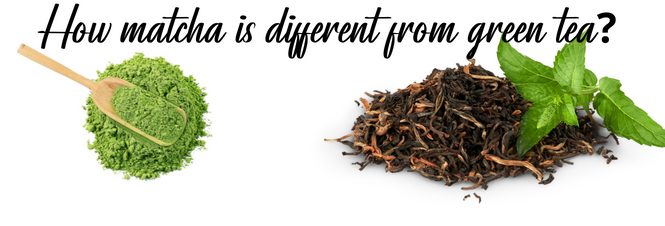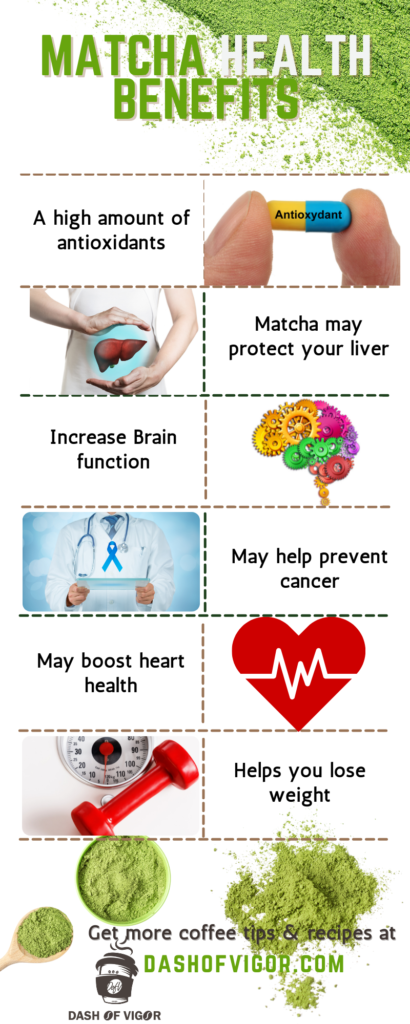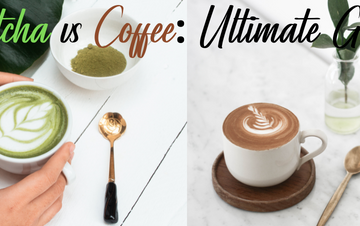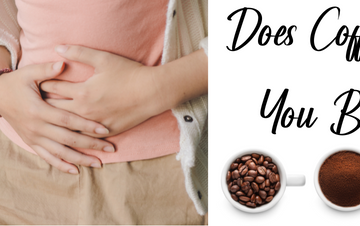
I guess you have seen the drink called “Matcha” on the menus of some cafes. Maybe you, like me, have wondered what is matcha tea powder.
I remember the first time I saw it and asked the barista. He told me briefly that matcha is a type of Japanese green tea. I ordered Matcha with hot milk and was very impressed with the taste.
I started researching this Japanese tea more in-depth and have prepared the valuable information I could find about it.
You will discover that consuming Matcha regularly can benefit your health, as well as how you can prepare this miracle drink yourself.
Enjoy reading.
TABLE OF CONTENTS:
- What is Matcha Tea (Powder)?
- Types of Matcha
- How to Prepare Matcha Tea?
- How To Drink Matcha?
- What Are The Matcha Health Benefits?
- Tips for making great Matcha
- Questions you may have
What is Matcha Tea (Powder)?
If you’re unaware of Matcha, it’s a Japanese green powder made of dry tea leaves that have been finely powdered. It has a mildly vegetal, bitter taste and a vibrant green hue due to the leaf’s high levels of chlorophyll. It’s been the basis of tradition-based Japanese rituals for hundreds of years.
The contemplative act of making, drinking, presenting, and serving Matcha is the foundation of the Japanese tea ceremony.
Matcha’s roots are ritualistic and akin to a ritual, the powder of green tea is widely used around the globe in drinks like tea, lattes, or boba tea, as well as an ingredient in cooking, from salad dressing to ice cream.
However, it has recently gained popularity in the US due to its benefits for health.
Green tea, which is regularly consumed, is widely regarded as a potent antioxidant.
However, Matcha offers even more significant advantages. Mix the powder with hot milk or water when preparing matcha tea. This means consuming the whole tea leaf every time you drink it!
The antioxidants it has can reduce blood pressure, decrease the risk of coronary heart diseases, and improve your body’s metabolism.
How matcha is different from green tea?

Like all authentic teas, Matcha originates from the Camellia sinensis plant leaf. How tea leaves are grown and processed is different from other teas.
Shade grown
Matcha is all made of shade-grown tea leaves, a labor-intensive procedure where the tea bushes are shaded from sunlight and light is channeled through the bushes in a highly controlled manner.
Shading enhances the production of chlorophyll within the plant, which gives the leaves a vibrant green hue.
Lack of sun decreases the photosynthesis process of leaves, which alters the natural levels of flavonols, caffeine sugars, antioxidants, and theanine.
By controlling sun exposure, tea makers can drastically change the chemical makeup and taste of the finished tea leaf.
Seasonal
Only the most recent blossoms and the three leaflets from the shade-grown tea plants are picked by hand for matcha production. This means that the production window is minimal, one reason matcha is among the most expensive teas.
Stone ground
Instead of being folded into a shape, dried, and then shaped as the traditional leaves of green tea, the matcha leaves will be dried flat and transformed into tencha, the leaf that matcha is made from.
Tencha leaves are removed from their stems and veins. The remainder of the leaf material is crushed in slow-turning stone mills, resulting in a smooth green powder.
Steamed
It is common practice for most Japanese teas to steam the tea leaves first. The same goes for matcha leaves.
Hours after plucking, the leaves should be treated briefly with steam heat. The steam heat stops the oxidation process, preserving the tea leaves fresh, green color.
Steaming the leaves creates a flavor profile that people often describe as herbal and sweet.
Consumption vs. extraction
As we all know, we must steep traditional tea leaves in hot water. Then we wait a few minutes to extract their aromas and chemical properties. After that, we must remove them from the water, and the tea is ready to drink.
With Matcha tea, the process develops differently. Matcha powder is mixed in hot water or milk until a homogeneous mixture is obtained, and after that, you drink it.
RELATED TOPIC: Does Tea Expire And How To Keep It Fresh
Types of Matcha
There are two types of Matcha:
Ceremonial grade
The Ceremonial Grade is the best quality matcha made from the finest meticulously cultivated flowers and leaves. Ceremonial grade is treated with the greatest detail concentration during processing to produce the freshest, most delicate tasting, and most smooth ground matcha. It is intended to be enjoyed as a treat by itself, without additional sweeteners or other additives to enjoy the original taste truly.
Ceremonial is significantly more costly.
The color is nice and lively green, and the taste is also distinct. It’s more smooth and less bitter. This is why it’s used in traditional ceremonies. It’s typically only used when you’re drinking it in its entirety. It’s not advisable to mix it with anything. If you’re a novice to matcha, you don’t have to purchase ceremonial grade, particularly if you’re planning to mix it with honey and milk.
Culinary Grade
The Matcha for cooking has a more robust flavor than other ingredients. It could also include ground leaves that have veins and stems. It could be duller than ceremonial grade and contain a mixture of matcha powder from various sources.
Compared to the Ceremonial grade, the Culinary grade is roughly half the cost, making it more affordable for those who are just beginning! It’s darker because it utilizes the rest of the leaves of the plant. The taste is affected and makes it bitter. That is why most people use this Matcha for cooking because the flavor’s complexity disappears.
Drinking Matcha of culinary quality is still possible, but you’ll need to include some natural sugars such as honey. It’s an excellent blend of Matcha with milk to make cocktails or drinks.
I prefer the culinary grade for daily use, and occasionally I’ll get the ceremonial version to indulge myself. I’ve found that the food is more earthy tasting. It makes this way of eating less expensive.
How to Prepare Matcha Tea?

INGREDIENTS
- 1-2 teaspoons (2-4 grams) of Matcha Powder
- 2 ounces (59 ml) of a cup of hot water
TOOLS
- Bamboo whisk
STEP-BY-STEP GUIDE
Matcha is prepared more uniquely than traditional tea and is extremely easy to make with the proper equipment.
Let`s see step-by-step how to prepare it:
- Boil the water (whatever you prefer).
- Let the water cool for 2-3 minutes.
- Put the teaspoons of Matcha powder in the glass.
- Splash some hot water over the Matcha powder.
- Mix the powder with water with the help of a bamboo whisk until you have a smooth paste.
- Put the rest of the hot water in the glass and stir with the bamboo whisk until you have a thin foam that is frothy over the top.
- Enjoy.
The amount of tolerable consumption for matcha powder is unclear and depends on each individual. To protect yourself, make sure you take matcha tea in moderate amounts.
It’s recommended to consume 1 to 2 cups daily and search for certified organic matcha powder to reap the many health benefits without the risk of adverse negative effects.
How To Drink Matcha?
It’s not likely that you require a Matcha guide to make Matcha. But be sure to think twice! It’s more challenging to make than typical tea, whether black or green tea.
The traditional method for making Matcha uses a particular bamboo whisk (called the chasm) and a clay bowl (called the chawan). Like green tea, it won’t taste good if you use too hot water. The leaves are still young, so you shouldn’t cause them to burn, which can lead to a bitter taste.
The ideal temperature is eighty degrees Celsius (176 Fahrenheit). I do not own a kettle for temperature, so I just bring water to a boil and let it rest for around 2 minutes before pouring it onto the top. Ensuring the water is at the correct temperature will let out the full flavor of the tea.
What Are The Matcha Health Benefits?
Matcha benefits are a lot, and they can help your health.
Let`s look at them.

A high amount of antioxidants
Matcha is an excellent source of catechins. They are a type of tea plant compound that function as natural antioxidants.
Antioxidants can help stabilize the harmful free radicals, substances that can harm cells and lead to chronic disease.
If you mix matcha powder into hot water to create tea, the tea is infused with all the nutrients of the whole leaf. It’s likely to contain more antioxidants and catechins than steeping traditional tea leaves in water.
According to one estimate, the number of catechins in matcha can be up to 137 times higher than in other kinds, including green tea.
One study demonstrated that feeding mice supplements containing matcha decreased the harm that free radicals cause and increased the antioxidant capacity.
Including matcha in your diet may increase the amount of antioxidants you consume that can help protect against cell damage and may even reduce your risk of contracting various chronic illnesses.
Matcha may protect your liver
The liver is essential to our health and plays an integral part in flushing toxic substances and metabolizing drugs in processing and storing nutrients.
Certain studies have shown that matcha could aid in protecting the well-being of your liver.
One study found that diabetic rats were given matcha to drink for 16 weeks, preventing liver and kidney damage.
Another study provided 80 people with nonalcoholic fatty liver diseases with either control or 500 mg extracts from green tea every day for 90 days.
Following 12 weeks of treatment, the green tea extract dramatically reduced levels of liver enzymes. These enzymes have elevated levels and are indicators of damage to the liver.
Additionally, the analysis of 15 studies showed that drinking green tea was linked with a lower risk of developing liver diseases.
However, it’s crucial to know that additional factors could be involved in this connection.
It is necessary to conduct more research to examine matcha’s impact on the overall population, given that most research is focused on investigating the effects of extracts from green tea on animals.
Increase Brain function
A study suggests that many of the ingredients in matcha may assist in boosting brain functioning.
A study of 23 participants examined how participants completed a set of tasks designed to test brain performance.
The participants could drink matcha-infused tea or a snack bar containing four grams of matcha. In contrast, the control group drank a placebo.
The researchers discovered that matcha improved reaction speed, attention, and memory compared to a placebo.
A second study found that taking 2 grams of green tea powder every day for two months improved cognitive function in older people.
Furthermore, matcha has more caffeine than green tea, delivering 35 milligrams of caffeine for a 1/2 teaspoon (about 1 gram) in matcha powder.
Numerous studies have linked caffeine consumption with improvements in brain function, including quicker reaction times, greater focus, and better recall.
Matcha also contains a chemical known as L-theanine that can alter coffee’s effects, increasing alertness and preventing a decrease of energy that could be triggered by caffeine intake.
Theanine also has been proven to enhance alpha waves in the brain. This can help induce relaxation and reduce stress levels.
May help prevent cancer
Matcha is packed with compounds that promote health and prevention of cancer in test tubes and animal research.
Matcha is exceptionally high in epigallocatechin-3-gallate (EGCG), a type of catechin shown to have potent anti-cancer properties.
A test tube study has discovered that EGCG in matcha could kill prostate cancer cell lines.
Other tests have demonstrated that EGCG can effectively battle lung, skin, and even liver cancer.
Be aware it was test tubes and animal studies focusing on particular compounds in matcha. More research is required to understand how these results could apply to human beings.
May boost heart health
Heart illness is the most common cause of death across the globe and accounts for around one-third of deaths among older people 35.
Certain studies have demonstrated how drinking tea with green leaves with a similar nutrient profile as matcha could aid in preventing heart disease.
It has also been found to lower total cholesterol levels, “bad” LDL cholesterol, and the amount of triglycerides.
It could also assist in preventing the oxidation process of LDL cholesterol, a different aspect that could help protect against coronary heart diseases.
Studies on observation have also revealed the consumption of green tea is linked with a lower risk of stroke and heart disease.
If paired with a balanced diet and a healthy lifestyle, drinking matcha could aid in keeping your heart healthy and help prevent disease.
Helps you lose weight
Look over the label of any weight loss product with a high chance that you’ll find “green tea extract” included in the list of ingredients.
Green tea is well-known for its capacity to increase the process of losing weight. Studies have shown that it can boost metabolism, which can increase the amount of energy expended and increase the burning of fat.
One study of a small size showed that drinking green tea extract when exercising helped to reduce fat loss by 17 percent.
A study of 14 people discovered that taking an herbal supplement with green tea extract increased a person’s energy expenditure for 24 hours over the substitute.
The review of studies revealed that green tea helped reduce body weight and assisted in maintaining weight reduction.
Although most of these research studies focused on green tea extracts, Matcha is derived directly from the same Source and could produce the same effects.
Tips for making great Matcha
- There are different types of Matcha. Buying Matcha for the first time is difficult – there are numerous brands, and they can vary in quality. I recommend looking for one that is free of added sugar. Beyond that, the main difference is between the culinary and ceremonial quality matcha. The one for ceremonial use is more expensive as it’s made with the earliest tea leaves and tastes mellow. You should choose it if you intend to drink your Matcha using only water. Other than that, cheaper culinary Matcha could suffice. Its flavor is bitter, and it works well in desserts or lattes.
- Matcha won’t last forever. Matcha does not have a very long shelf time. You should use it within two months to get the best flavor and color when you’ve opened it. I suggest buying smaller quantities and storing them in the refrigerator to ensure freshness.
- Invest in a matcha whisk. If you are a frequent maker of Matcha, I suggest investing in bamboo whisks. The unique design breaks apart the clumps and produces a soft foam layer on the tea’s surface. If you don’t have a whisk, use a regular whisk or an electronic milk mixer instead. Mixing or stirring using the fork or spoon will likely not work in this case.
- Sweeten as desired. Matcha’s umami-like, grassy taste is a taste that can be difficult to master. If you’re brand new to the process, don’t be reluctant to add some drops of honey or maple syrup. It is also possible to sweeten your tea in case your matcha powder is bitter.
Questions you may have
How do you make matcha taste better?
To enhance the taste of the matcha you decide to consume, you can apply the following techniques:
- Check out the matcha’s quality and its preparation method
Matcha that’s dull-brown or yellow-green in hue is low-grade matcha. It is most likely to taste bitter if consumed as a drink. I suggest you use this kind of matcha for cooking.
Matcha must be beautifully green and possess an almost grassy, fresh scent. You must pay attention when heating milk or water for it. Using hot liquids above 175 degrees F can cause matcha’s taste to be bitter. Lowering the water temperature will make the matcha have a mellow flavor.
- You can use less Matcha
The flavor of matcha is directly proportional to the amount of matcha utilized. Using more matcha will get more flavor. If the taste is too strong, using less matcha is a great option to decrease the intensity.
If you’re unable to taste matcha doesn’t mean you’re not benefitting from the advantages. The goal is to be able to enjoy the drink. Adding more matcha to your drink is simple, but it’s much more difficult to get it out once you’ve got it inside.
- Make Matcha a side-character
Matcha can be concealed in smoothies or as in a topping on fruits like ice cream or yogurt. Matching matcha with creamy drinks such as milk, oatmeal milk, or milkshakes could assist in masking the flavor and reducing the color. A dollop of the whipped cream into the matcha-based drinks could produce the same result. Naturally, matcha can be used for baking too. However, since there is some cost variation, I suggest using the culinary grade matcha when cooking.
- You can use a flavored Matcha
Each flavor is delicate and complements matcha’s natural properties without being overpowering. Matcha has no sweeteners and is frequently described as “naturally sweetness.”
With the addition of new flavors regularly, there is sure to be one that will suit your preferences.
- Try to sweeten your Matcha
The natural vegetal taste of matcha could be mistaken for bitterness. Even though properly made matcha is not bitter, it does require some time to get used to. Making matcha sweeter is another method of making it more enjoyable. Sugar and agave syrup can keep matcha’s flavor intact, while sweeteners such as chocolate and honey can help mask the taste.
Matcha drinks offer a wealth of health benefits. However, excessive use of sweeteners could result in a negative effect. If you can, try to use a natural sweetener or one with as little sugar as possible.
Can I drink matcha everyday?
Matcha is safe to use daily, but it depends on the quantity.
One of the most important things to remember about the amount of matcha you drink is the high amount of caffeine.
Like coffee, you must consume matcha in moderation, pay attention to your body and limit caffeine consumption to mid-afternoon.
Most adults can take up to 400 mg of caffeine daily. It is allowed to consume five teaspoons per day. Matcha’s caffeine has the advantage of giving you greater energy for longer and giving you less jittery than coffee.
If you’re pregnant or have an intolerance to caffeine, however, you should consult your doctor before adding matcha to your diet!
Does matcha stain teeth?
Like all green tea, tannins can cause stains on your teeth in time. But matcha tea is also renowned for its numerous advantages for the health of your mouth.
Instead of harming teeth, it is beneficial for them. Matcha is rich in amino acids and catechins, antioxidants that help fight tooth decay.
It has antibacterial properties that stop the growth of the bacteria responsible for cavities and can help combat gum disease. The antioxidants in matcha green tea modify the sulfur compounds within your mouth that produce unpleasant breath. Even though matcha tea gets the green light does not mean you have to eat everything you see.
Remember that sugar can harm enamel; the ingredients typically pack matcha sweets and lattes.







